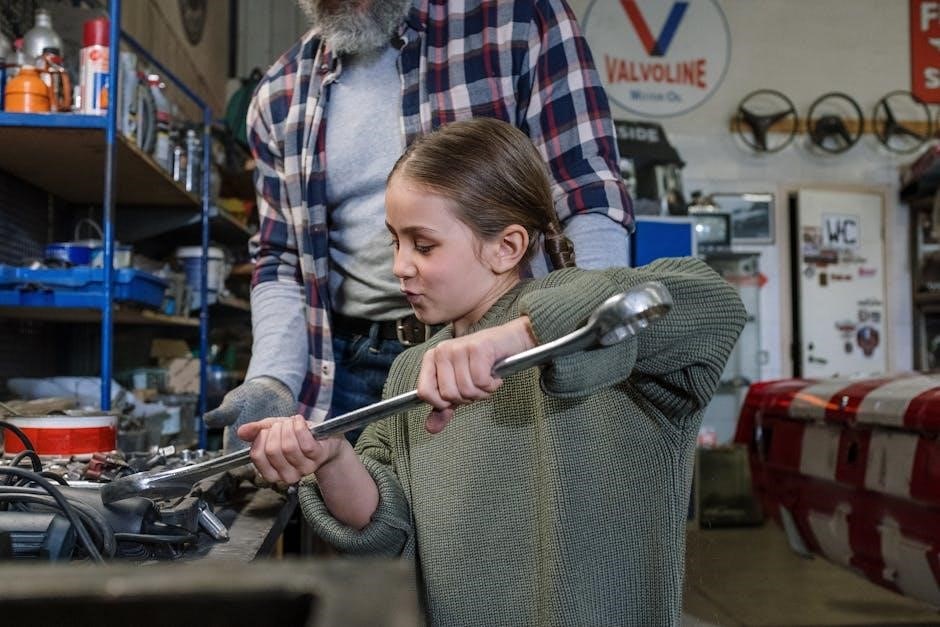How Long Does It Take to Learn Manual Transmission?
Learning manual transmission varies per individual, typically ranging from a few days to several weeks. Initial basics take 2-3 days, while comfort in traffic requires 20+ hours. Mastery develops over weeks, influenced by prior experience and practice frequency.

Initial Familiarity with Basics (2-3 Days)
Mastering the fundamentals of manual transmission typically takes 2-3 days. During this period, learners focus on understanding how the clutch and gearshift work together. Starting in a stationary position, they practice pressing the clutch, shifting gears, and slowly releasing the clutch while accelerating. This stage involves getting comfortable with the physical sensations and coordinating hand and foot movements. Many report stalling frequently at first, but persistence helps build muscle memory. By the end of this phase, learners can usually start, stop, and shift gears smoothly in a controlled environment. While progress varies, consistent practice during these initial days lays a solid foundation for more complex driving scenarios. Feeling discouraged is normal, but staying committed ensures steady improvement. This period is crucial for developing the basic skills needed to progress to more challenging conditions.

Comfort in Various Traffic Conditions (20+ Hours)
Gaining comfort in different traffic conditions typically requires over 20 hours of practice; This phase involves moving beyond basic gear shifting to navigating real-world scenarios. Learners start by practicing in controlled environments like empty parking lots before progressing to quiet streets. As confidence grows, they tackle more challenging situations, such as city driving, stop-and-go traffic, and highway speeds. During this time, they refine their ability to anticipate and respond to traffic flow, coordinating clutch and accelerator use seamlessly. Challenges like uphill starts, turning at intersections, and merging onto busy roads become less daunting. Regular practice helps reduce stalling frequency and builds muscle memory. By the end of this phase, drivers feel more at ease handling various conditions, demonstrating improved control and smoother transitions. This stage is crucial for developing the instincts needed to drive a manual transmission vehicle effectively in everyday situations, ensuring safety and efficiency on the road.
Mastery of Smooth Shifting and Control (Several Weeks)
Mastery of smooth shifting and control typically takes several weeks of consistent practice. By this stage, drivers have moved beyond basic gear changes and can transition between gears effortlessly, even in complex scenarios. The key focus is on developing a natural “feel” for the clutch and accelerator, allowing for seamless acceleration and deceleration. Drivers learn to anticipate when to shift based on speed, terrain, and traffic flow, reducing jerky movements and stalls. This phase also involves refining techniques like downshifting before braking and handling uphill starts with confidence. Mastery is achieved when shifting becomes second nature, and the driver can navigate any road condition smoothly. Regular practice is essential to solidify these skills, as muscle memory and instincts take time to develop. With dedication, drivers can transition from conscious shifting to intuitive control, making manual driving feel effortless and enjoyable.

Factors Affecting Learning Time
Several factors influence how long it takes to learn manual transmission. Previous driving experience plays a significant role, as those familiar with automatics may still need time to adapt to manual shifting. However, prior knowledge of driving basics can accelerate the learning process. Frequency of practice is another critical factor; regular and consistent practice speeds up mastery, while irregular practice slows progress. Individual learning pace also varies, as some may pick up skills faster than others. Additionally, the environment in which one practices—such as quiet neighborhoods versus busy traffic—can impact learning speed. The type of vehicle, especially its torque and clutch sensitivity, also affects the ease of learning. Some vehicles are more forgiving, making the process smoother for beginners. Overall, these factors combine to determine the time it takes for each person to become proficient in driving a manual transmission car.
Previous Driving Experience
Previous driving experience significantly impacts the time required to learn manual transmission. Drivers with prior experience in automatic vehicles may find the transition challenging, as manual shifting introduces new skills like clutch control and gear coordination. However, their familiarity with basic driving concepts, such as acceleration and braking, provides a foundation that can speed up the learning process. For instance, understanding the relationship between speed and gear selection is easier for those who have already mastered these fundamentals. Conversely, individuals with no prior driving experience may face a steeper learning curve, as they need to grasp both driving basics and manual shifting simultaneously. Nonetheless, consistent practice can help bridge this gap, allowing even newcomers to become proficient over time. The ability to apply existing knowledge effectively makes previous driving experience a key determinant in mastering manual transmission efficiently.

Frequency of Practice
The frequency of practice plays a crucial role in determining how quickly one masters manual transmission. Regular and consistent practice accelerates the learning process, as it builds muscle memory and improves coordination between clutch and accelerator pedals. For instance, dedicating a few hours daily to practice shifting gears and controlling the vehicle in various conditions can significantly reduce the overall learning time. On the other hand, sporadic or infrequent practice may prolong the process, as the driver lacks the opportunity to refine their skills continuously. Studies and anecdotal evidence suggest that drivers who practice consistently for 20 or more hours in diverse traffic scenarios tend to feel more comfortable and confident behind the wheel. Ultimately, the key to mastering manual transmission lies in consistent and focused practice, allowing drivers to gradually refine their techniques and adapt to different driving situations.

The Learning Process

Mastery of manual transmission follows a structured progression, starting with understanding the fundamentals. Initially, learners focus on coordinating the clutch and accelerator pedals, practicing in a controlled environment. As they gain confidence, they transition to real-world traffic, refining their skills in various conditions. The journey from stalling frequently to smooth, intuitive shifting demands patience and consistent practice. Regular sessions, especially in diverse driving scenarios, accelerate the learning curve, enabling drivers to navigate challenges with ease. Over time, the synchronization of gear shifts with the car’s speed becomes second nature, marking the final stage of proficiency. This gradual process ensures that drivers not only learn but also master the art of driving a manual transmission vehicle effectively.

Stage 1: Understanding the Basics

Stage 1 focuses on grasping the fundamental mechanics of manual transmission. Learners begin by familiarizing themselves with the clutch, gearshift, and their roles in controlling the vehicle. This initial phase involves understanding how the clutch disengages the engine from the transmission and how shifting through gears corresponds to speed changes. Practicing in a stationary vehicle helps build muscle memory for clutch and accelerator coordination. Tutorials and guidance from experienced drivers provide a foundation for safe and effective learning. This stage is crucial as it sets the groundwork for progressing to practical application. Mastery of these basics typically takes 2-3 days, after which learners can move on to applying their knowledge in real driving scenarios.
Stage 2: Practicing in a Safe Environment

Stage 2 involves applying the theoretical knowledge gained in Stage 1 through practical exercises in a controlled, low-risk setting. Learners typically start in an empty parking lot or quiet street, where they can focus on mastering basic operations like starting, stopping, and shifting gears without the pressure of traffic. This phase emphasizes smooth clutch engagement, proper gear selection, and coordination between the clutch and accelerator pedals. Practicing in a safe environment allows learners to build confidence and refine their skills without the stress of real-world driving scenarios. A qualified instructor or experienced driver often provides guidance and feedback during this stage. Regular practice in a safe setting helps learners progress from stalling frequently to achieving smoother transitions between gears. This phase is essential for developing muscle memory and preparing for more challenging driving conditions.
Stage 3: Building Confidence on the Road
Stage 3 focuses on applying learned skills in real-world driving scenarios, helping learners gain confidence and adaptability. This phase involves navigating various traffic conditions, such as stop-and-go traffic, uphill climbs, and merging onto busy roads. Learners practice smooth shifting, clutch control, and maintaining rhythm while driving in dynamic environments. Starting in low-traffic areas, they gradually progress to busier roads, refining their ability to anticipate and react to situations. Consistent practice in these conditions helps build muscle memory and reduces hesitation. Over time, learners become more comfortable with the manual transmission, mastering techniques like downshifting for braking and upshifting for acceleration. This stage is crucial for transitioning from a controlled practice environment to independent driving. With patience and repetition, learners develop the skills and confidence needed to handle any driving situation effectively. Regular feedback from instructors or experienced drivers further enhances progress during this phase.
